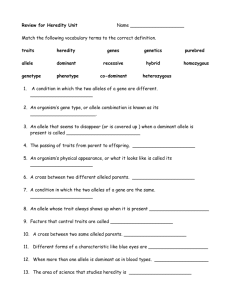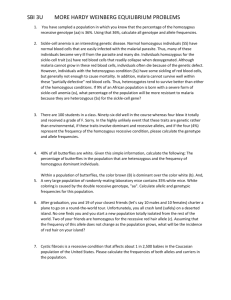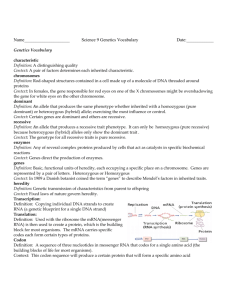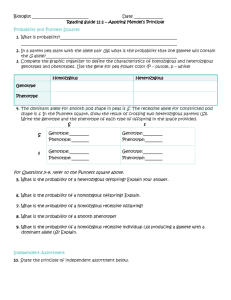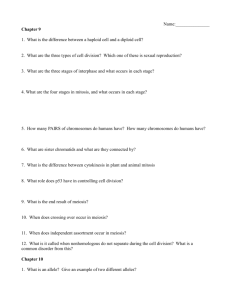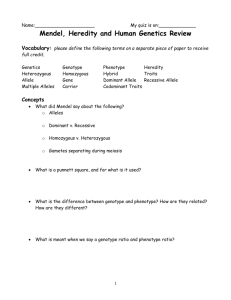NMPED 01/20-23/15 Theme: Classifying and Exploring Life Science
advertisement
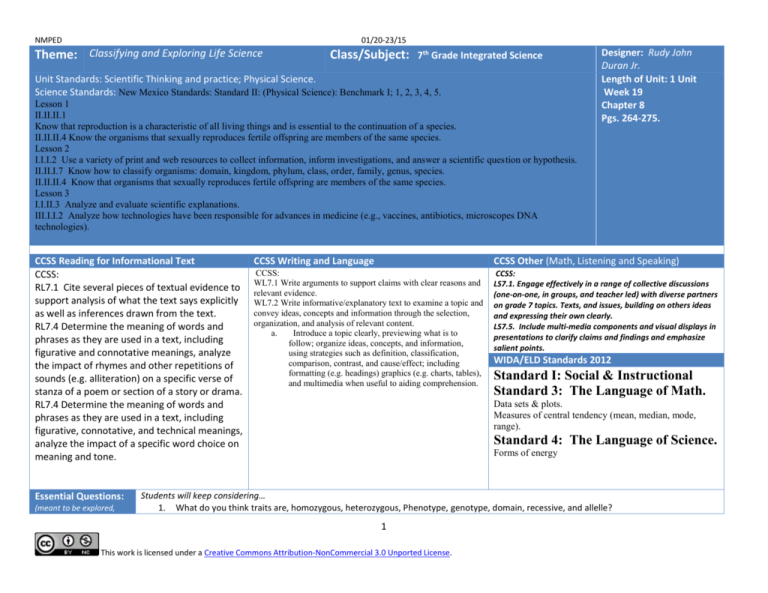
NMPED Theme: 01/20-23/15 Classifying and Exploring Life Science Class/Subject: 7th Grade Integrated Science Unit Standards: Scientific Thinking and practice; Physical Science. Science Standards: New Mexico Standards: Standard II: (Physical Science): Benchmark I; 1, 2, 3, 4, 5. Lesson 1 II.II.II.1 Know that reproduction is a characteristic of all living things and is essential to the continuation of a species. II.II.II.4 Know the organisms that sexually reproduces fertile offspring are members of the same species. Lesson 2 I.I.I.2 Use a variety of print and web resources to collect information, inform investigations, and answer a scientific question or hypothesis. II.II.I.7 Know how to classify organisms: domain, kingdom, phylum, class, order, family, genus, species. II.II.II.4 Know that organisms that sexually reproduces fertile offspring are members of the same species. Lesson 3 I.I.II.3 Analyze and evaluate scientific explanations. III.I.I.2 Analyze how technologies have been responsible for advances in medicine (e.g., vaccines, antibiotics, microscopes DNA technologies). CCSS Reading for Informational Text CCSS: RL7.1 Cite several pieces of textual evidence to support analysis of what the text says explicitly as well as inferences drawn from the text. RL7.4 Determine the meaning of words and phrases as they are used in a text, including figurative and connotative meanings, analyze the impact of rhymes and other repetitions of sounds (e.g. alliteration) on a specific verse of stanza of a poem or section of a story or drama. RL7.4 Determine the meaning of words and phrases as they are used in a text, including figurative, connotative, and technical meanings, analyze the impact of a specific word choice on meaning and tone. Essential Questions: (meant to be explored, Designer: Rudy John Duran Jr. Length of Unit: 1 Unit Week 19 Chapter 8 Pgs. 264-275. CCSS Writing and Language CCSS Other (Math, Listening and Speaking) CCSS: WL7.1 Write arguments to support claims with clear reasons and relevant evidence. WL7.2 Write informative/explanatory text to examine a topic and convey ideas, concepts and information through the selection, organization, and analysis of relevant content. a. Introduce a topic clearly, previewing what is to follow; organize ideas, concepts, and information, using strategies such as definition, classification, comparison, contrast, and cause/effect; including formatting (e.g. headings) graphics (e.g. charts, tables), and multimedia when useful to aiding comprehension. CCSS: LS7.1. Engage effectively in a range of collective discussions (one-on-one, in groups, and teacher led) with diverse partners on grade 7 topics. Texts, and issues, building on others ideas and expressing their own clearly. LS7.5. Include multi-media components and visual displays in presentations to clarify claims and findings and emphasize salient points. WIDA/ELD Standards 2012 Standard I: Social & Instructional Standard 3: The Language of Math. Data sets & plots. Measures of central tendency (mean, median, mode, range). Standard 4: The Language of Science. Forms of energy Students will keep considering… 1. What do you think traits are, homozygous, heterozygous, Phenotype, genotype, domain, recessive, and allelle? 1 This work is licensed under a Creative Commons Attribution-NonCommercial 3.0 Unported License. NMPED revised, meant to provoke thought in students, genuine questions, various possible answers) 01/20-23/15 2. 3. What is an allele? What knowledge about homozygous, heterozygous, phenotype, genotype, domain, recessive, and traits? Concepts Skills Students will know… What facts and basic concepts should students know and be able to recall? Define homozygous, heterozygous, phenotype, genotype, dominant, recessive, and allele. Students will be able the phases of cell division. Students will identify characteristics of organisms that sexually reproduce fertile offspring are members of the same offspring. Students will be skilled at… What discrete skills and processes should students be able to use? Students will be able to distinguish, analyze, genetic traits. Students will be able to tell the cycle of Mitosis and cell reproduction. Students will be skilled using a variety of print and web resources to collect information, inform investigations, and answer scientific questions or hypothesis. Students will be skilled at knowing homozygous, heterozygous, phenotype, genotype, dominant, recessive, and allelle. Students will be skilled at identifying characteristics of sexual and a sexual reproduction, genes, recessive dominant, & Allelle. Academic Language (Tier 1, 2, 3 vocabulary): *Homozygous Singular Cellular *Heterozygous Multi-cellular * Phenotype Prokaryote * Genotype Eukaryote * Dominant Mitosis Phases Other vocabulary DNA Helix Sexual Reproduction Asexual Reproduction Mitosis Cycle Anaphase Telephase Metaphase * Recessive *Allelle Resources: Text Connections: Connect Ed Reading Chapter 8, in the McGraw-Hill Science book. McGraw-Hill Teacher’s Edition Internet resources to connect to texts. Online Resources Equipment, lab equipment Science Spot.net Learning Target Statements: (Student-Friendly) Assessments: Formative (F) and Summative (S) Daily Content Objectives (in student friendly “I will” statements) Level 1 Knowledge Daily Language Objectives (in student friendly “I will” statements) Formative Assessment: Learning Targets 1. Distinguish between a homozygous, heterozygous, phenotype, 1) Mid Term Exam Recall/Reproduction genotype, dominant, recessive, and allele. 2) Chapter Tests 2 This work is licensed under a Creative Commons Attribution-NonCommercial 3.0 Unported License. NMPED 01/20-23/15 3) Lab or Project based Assessment. Summative Assessment: 1) Do Nows: 2) Quizzes 3) Socratic Questioning, Exit Tickets Level 2 Knowledge Learning Targets Skills/Concepts 1. Level 3 Knowledge Learning Targets 1. 1. Give examples of between homozygous, heterozygous, phenotype, genotype, dominant, recessive, and allele. 1. 2. 3. 4. Cooperative grouping: Think Pair Share/Power Teach. Class discussion and corrections/clarify, inquiry based learning. Quarter Exam Connect Ed online quiz. List all parts of homozygous, heterozygous, phenotype, genotype, dominant, recessive, and allele. 1. 2. 3. Written and Verbal quizzes. Quarter Exam Connect Ed online quiz. Students will learn homozygous, heterozygous, phenotype, genotype, dominant, recessive, and allele. Use the organisms that sexually reproduce fertile offspring are members of the same offspring, homozygous, heterozygous, phenotype, genotype, dominant, recessive, and allele. 1. 2. 3. Direct Observation. Daily Practice. Scientific method of problems solving: long term observation. Connect Ed online quiz. Strategic Thinking/Complex reasoning Level 4 Knowledge Learning Targets Extended Thinking/Reasoning 2. 4. Ideas for Differentiating Activities: (Must include a Hook, Closure, and Assignments) Small group: Read the tests to SPED/ELL students. Think Pair Share. Partner Projects/Labs. Have students teach other students in small groups. M NO SCHOOL: Martin Luther King Jr. Day T Do Now: Make a Prokaryote and Eukaryote Booklet. Emotional Hook: Video: Skin Grafting. -Lesson: Students will work on making their prokaryote and eukaryote booklets. Then finish their Plant and Animal Cells. Objective: Students will know the differences between a prokaryote, Eukaryote, Single celled organism, or Multicellular Organism. Students will finish working on their Plant Cells Drawing Models. : Make a Prokaryote and Eukaryote Booklet. Summary(Formative/Summative): Check Tickets (Oral) 3 This work is licensed under a Creative Commons Attribution-NonCommercial 3.0 Unported License. NMPED 01/20-23/15 W TH F -Do Now: Make a Prokaryote and Eukaryote Booklet. Emotional Hook: Video: Skin Grafting. Read/discuss: Make a Prokaryote and Eukaryote Booklet. Students will finish working on their Plant Cells Drawing Models. Objective: Students will know the syllabus, discuss agenda. -Closure: Check out Tickets (Oral) NMSBA: Do Now: What is Phenotype? What is Genotype? What is Allele? Emotional Hook: Dolly Video. -Lesson: Students will learn the phases of mitosis. Objective: Students will know the cell cycle and cell division through building their Mitosis Movie Book Analyze the phases of mitosis. Synthesize the phases of mitosis. Define the phases of mitosis. Closure: Check Out ticket: What is the cell cycle, interphase, sister chromatid, centromere, mitosis, cytokinesis, daughter cell. -Lesson: Do Now: What is a Dominant gene? What is a Recessive Genes? Emotional Hook: Dolly Video. -Lesson: Students will finish working on their Mitosis Movie Book. If finished have students read Chapter 8 aloud. Objective: Students will know the cell cycle and cell division through building their Mitosis Movie Book Analyze the phases of mitosis. Synthesize the phases of mitosis. Define the phases of mitosis. Closure: Check Out Ticket . -3:00 Teams will be dismissed for Team Building (Movie). Objective: Student will -Closure: Exit Tickets (Oral) 4 This work is licensed under a Creative Commons Attribution-NonCommercial 3.0 Unported License.



